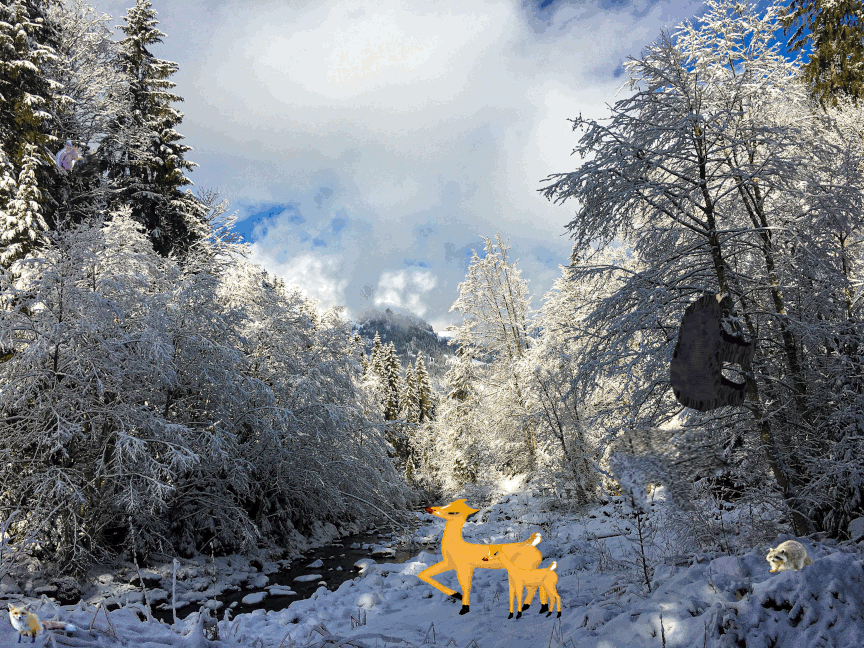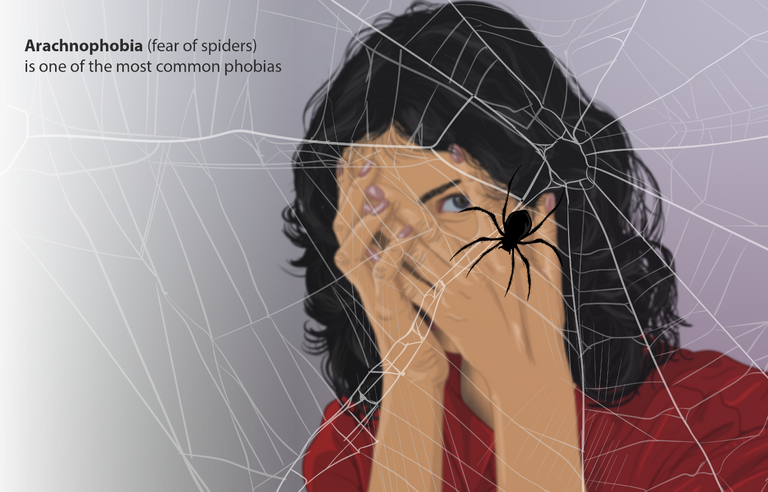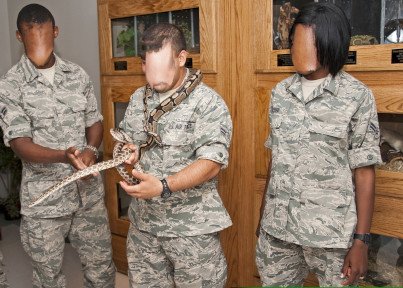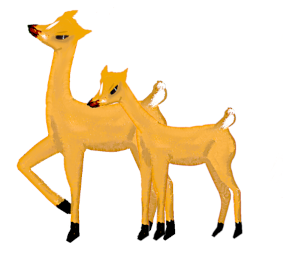Does A Bear Falling From a Tree Develop a Phobia? A Collage for LMAC #105

In my collage for LMAC #105, a chubby bear climbs a skinny tree and the inevitable happens: the bear comes tumbling down. Maybe that bear will be afflicted in the future with a fear of heights--acrophobia. If so, the bear would have a lot of company. According to a cross-cultural analysis of research studies (published in Cambridge University Press, 2017), specific phobias are "common". Numerically, 'common' translates into a (lifetime) occurrence in 7.4% of the world's population. The data may be somewhat compromised because it is subject to research limitations, which includes under reporting/diagnosis, especially in low and middle income countries.
Depiction of a Person with Arachnophobia

Image credit:https://www.myupchar.com/en, used under CC 4.0 license. One of the most common types of specific phobia, this fear may also include fear of spider webs.
What is a Phobia?
According to the DSM-5, in order to be diagnosed as having a phobia, a person has to demonstrate certain characteristics. The fear has to be irrational--that is, significantly out of proportion to the feared event or object. The fear occurs instantaneously when the phobic is confronted with the object or situation. And this phobic reaction has to have been present for more than six months. It also has to result in avoidance. That is, the person with the phobia will actively avoid exposure to the feared object or situation.
Fear of Flying: Aviophobia, or Aerophobia

The video is used under a CC 4.0. license.
The illustration above links to a brief video, produced by lIlya at Simpleshow Foundation (http://www.anxietycoach.com/fearofflying.html), which explains, "what fear of flying means and which simple tricks you can use to be able to better control the physical symptoms at least".
Phobia Causes
Sources I consulted suggest a likely genetic association with the development of phobia, coupled in most cases with a negative, fear-inducing experience. Twin studies show that twins raised in separate environments may both develop the same specific phobia. This is strongly suggestive of a genetic link.
One of the most interesting factoids I came up with in my research is an apparent genetic association with the development of a phobia: blood injury injection phobia, otherwise referred to as BII phobia. This has been observed in approximately 3-4% of the general population. (Again, these statistics are influenced by reporting and diagnosis issues in different cultures).
Fear of Needles

Image credit:M Joko Apriyo Ptro. Used under CC 4.0 license The caption under this picture reads: "A member of the public who receives the dose 1 vaccination must be held by 2 members of the army for fear of needles."
People who have BII phobia are "likely to faint at the sight of blood, the anticipation of physical injury, or the anticipation of an injection"(From the journal Behavioral Neurology) The physiological response in BII phobia is quite distinct and can be severe. Hindawi Journal reports that such people may "...experience a diphasic cardiovascular response of an initial tachycardia, followed by bradycardia, hypotension, shock, vertigo, syncope, diaphoresis, nausea, and seldom asystole and death..."
Enochlophobia: Fear of Crowds

Image credit: colocreator. Used under CC 4.0 license. According to one phobia-centered website, Fearof.net, this phobia is closely related to agoraphobia.
What are the Most Common Phobias?
(The information presented in this list is derived from the Psychiatry Associates of Baton Rouge. LLC.)
The most common phobias are:
Arachnophobia:Spiders, said to be the most common phobia.
Ophidiophobia:Snakes--according to the Baton Rouge website, this is believed by some to be rooted in our evolutionary past, and in experience.
Acrophobia:Heights, often associated with panic attacks and avoidance behavior.
Aerophobia:Fear of flying.
Cynophobia:Fear of dogs--"one of the most commonly treated phobias (usually stemming from a traumatic experience with a dog".
Social Phobia:"Fear centered around social situations and interactions".
Agorophobia:Includes fear of confined spaces, crowds, or airplanes--anyplace "where a quick escape is not possible".
Treatment
In most cases, treatment does not eliminate the fear completely. The treatment goal is to make the fear less limiting. According to the Mayo Clinic, exposure therapy and cognitive behavioral therapy are the most effective treatments. Medication is also used to control symptoms and related anxiety.
Exposure to Snakes to Limit Fear

Image credit: U. S. Airforce. Public domain. Military personnel handle a rat snake "to overcome the fear of nonvenomous snakes".
One new treatment the Mayo Clinic doesn't discuss (with regard to phobia treatment) is EMDR. (Eye Movement Desensitization and Reprocessing)but one that works with post traumatic stress is EMDR. (Eye Movement Desensitization and Reprocessing) This treatment has been used with patients who have PTSD, but is less commonly used to treat phobia.
While exposure therapy is a treatment favored by the psychiatric community, it has been shown to be effective more in the short term. than the long term.

The elements in my collage came from three sources: @shaka's template photo, images in the LIL Gallery, and my own resources.
Template Photo by @shaka

This picture was so beautiful I made a decision not to mar it. Therefore I had to introduce elements that blended with the scenery. Thank you @reheadpei for the squirrel, the raccoon, and the fox. These three critters were borrowed from the LMAC Image Gallery, LIL. (@redheadpei is a 4% beneficiary on this post because I used three of her images and these were indispensable).
I created the deer on my own by using a photo I took last week of a lawn decoration. This was the model upon which my deer were based:

The bear is also from the LMAC Image Gallery, LIL. I contributed this picture some time ago.
Join Us
LMAC is a welcoming community of people who like to create. Some of us are artists and some are not (me). However, we all have fun and everyone has the chance to win a prize. It's hard to tell which collages will end up as a finalist.
Although I do not compete in the contest, every week I make a collage. It is like a tonic for me.
This week's template photo and contest rules may be found at @shaka's blog here. Our image gallery welcomes contributions from all Hive bloggers and everyone on the platform is invited to borrow from the gallery. Rules and process are described in @shaka's blog here.
Thank you @shaka for creating the community and doing the work necessary to keep it vibrant.



I always love your works in motion, it gives it a touch of personality. Even though this week's image was a challenge, you know how to make a difference. From the effects on the river, like the bear in the tree, it's unfortunate his fall but it's quite original, I'm impressed with your creativity!
You are so kind! I love country scenes and so feel quite peaceful when I'm involved with such an image. While it is fun to surprise people, with a scene like this I imagine I am there :) That is a good feeling.
Hope you have a most happy week.
Congratulations @agmoore! You have completed the following achievement on the Hive blockchain and have been rewarded with new badge(s):
Your next target is to reach 19000 upvotes.
You can view your badges on your board and compare yourself to others in the Ranking
If you no longer want to receive notifications, reply to this comment with the word
STOPTo support your work, I also upvoted your post!
Check out the last post from @hivebuzz:
Support the HiveBuzz project. Vote for our proposal!
Thank you @hivebuzz for the notice and the upvote!
You're most welcome @agmoore and thank you for your vote on our proposal.
The thing is you have set "lemouth" as your voting proxy. Therefore, you no longer have any personal power over governance (witness votes, proposal votes, ...) unless you control that account.
And it turns out that your proxy does not support our proposal.
Either ask your proxy to support us, or remove your proxy and regain full control over your governance choices.
The HiveBuzz team wishes you all the best for 2022! Have a Happy New Year ✨🥂✨
Thank you for that information. I do have @lemouth as proxy. He understands the governance of the platform much more than I do. He understands the needs of the platform much more than I do. If I were to make decisions about the platform it would be like a voter going into the voting booth in November (in the U. S.) without any significant information about the candidates or issues. Irresponsible. I trust @lemouth as much as I trust anyone on the blockchain.
Sorry...my proxy vote is a considered decision. If I see @lemouth behaving in a way that undermines my trust, I will remove that proxy.
I wish you well and success.
No problem. Fully understandable. We will then have to convince him 😅
Yes!!! That's the way. He is a theoretical physicist. Reason is his specialty :))
Hehe, looks like he convinced himself. Is that what physicians call feedback loop? 😁
Thanks for your trust. This is appreciated.
🙂
I have read the proposal and added my support. Thanks for the notice.
Tagging @agmoore for information.
Thank you for your support @lemouth, much appreciated!
Pobre oso, se asusto mucho, yo le tengo miedo a las alturas.
Thank you so much, my friend @tormenta. The bear is quite chubby and did not get hurt when it hit the soft snowy ground. I would never injure a bear :))
Happy holidays to you, my friend.
igual para ti mi estimada. Abrazos.
Hermoso collage amiga un paisaje de ensueño y espectacular. Saludos.
Thank you @poderart. This was a pleasure to make. I like imagining myself in that scene. Quite peaceful.
Have a most wonderful, healthy New Year.
Hermoso collage amiga un paisaje de ensueño y espectacular. Saludos.
Hello friend, excellent information on phobias in humans, a great animation of animals in collage, happy new year 2022.
Thank you my friend, @cetb2008. Happy New Year to you and your lovely family!
Un collage divertido, dinámico y lleno de vida. Me encanta el oso. Y, como siempre, lleno de información muy interesante. Conocí una vez a una profesora que no podía ver una serpiente ni siquiera en fotografías. Realmente la pasaba mal.
Una cosa curiosa de las fobias es que hay fobias que son supercuriosas, como la Hexakosioihexekontahexafobia, la cual, por Dios, sí que tiene un nombre imposible.
Thank you for your visit and your kind words. I never heard of that phobia before, but I can understand it. Deep-seated roots in the culture. Besides the genetic link, what is the origin of our fears? Fascinating subject.
Hope you are well and not too busy.
Take care, my friend @adncabrera
I didn't know about this phobia either, until very recently, and what impresses me the most is the name.
I've thought a lot about fear. As you may know, my stories tend to focus there. I think anyone who fantasizes about scary stories has to engage with it. You can't play with fire without getting burned, even a little bit.
My present fears are more sophisticated elaborations (perhaps) of my childhood fears. I fear the dark depths, just as I used to fear the dark universe under my bed.... They are a source of creatures, of possibilities of you being trapped and left wandering blindly in an infinite womb, absolutely alone.
And maybe if I look at it a little better, this fear is a childish fear of abandonment (maybe).
Now, a fear is a fear. It grows with us and eventually we can rationalize it or sublimate it (which is what I do with fiction), however, phobias seem more complicated, because of the genetic component involved, if I understood your article correctly.
A Big hug, muy dear @agmoore
Your content has been voted as a part of Encouragement program. Keep up the good work!
Use Ecency daily to boost your growth on platform!
Support Ecency
Vote for new Proposal
Delegate HP and earn more
Thank you @ecency. I appreciate the recognition and the support!
You’re an expert in the animation field A.G. @agmoore. love how the bear tumbles down on the bend branch and the animals scatter.
My big phobia is Ophidiophobia. I didn’t know this term before reading your post. Nothing helps and there are no poisonous ones here. I think it’s inherited as my mother was terrified of them too. As long as the creature has legs I’m ok. LOL
I appreciate you included my images in your collage.
I hope all is going well and you are having a wonderful holiday week, my friend.💛
Happy New Year my friend. I remembered your snake phobia when I wrote this. I have many fears, but only one true phobia: cliffs. It's got a name. Cremnophobia. It's a long story but almost definitely related to childhood experiences around cliffs and sheer drops.
I appreciate your very kind words about my collage. It is so much fun for me making these.
Looking forward to 2022 and to more adventures in art. I hope very much to 'see' then. I has been such a pleasure knowing you.
The bear ran away poor him. I also have a phobia of heights, a year ago I went up to the terrace of a 5 story building and everything started to spin and I was desperate to go down! Excellent Collage on the move.
Thank you very much for stopping by and for your kind words about my collage. I think many people have phobias, even more than the numbers in my article suggest. When I bring it up to people so many say they have this or that phobia. Me too. Cliffs. Very specific phobia. I am terrified of cliffs. Fortunately, I live on flat land :))
Happy New Year, @nbarrios67 !
Likewise, my best wishes for the year 2022. I wish you good health and prosperity. Happy New Year!
I didn't know about the possibility of phobias having a genetic origins. I am happy to learn new things every day ;)
I have a personal weird phobia that concerns eyes. As soon as things such as a finger or a needle get close to an eye, I become totally stuck. This is of course completely irrational, but this is what a phobia is at the end of the day, as you phrased it.
Cheers and happy new year!
Do you remember a movie called Saturn 3 with a menacing robot removing a splinter from a woman's eye?
https://www.avforums.com/articles/saturn-3-in-proud-defence-of-an-sf-cult-classic.9591
I didn't see that movie, and I don't want to click... ;)
Hi @lemouth,
I tried to find a name for this fear...closest I came was ommetaphobia. This isn't exactly what you describe but it does have to do with fear of eyes, or eyes being injured.
I think the statistics for phobias are higher than what the research shows. lot of people I know say they have a phobia. I definitely have on: fear of cliffs (cremnophobia). It may have genetic roots, but none of my sibling has phobias, as far as I know and I've never heard about a second degree relative that has one. I think in my case it might be very directly connected to the fact that my brothers tossed me off a cliff (yes!) when I was very, very young. They offered me the option of swinging from a vine or falling into an abyss. Has to be connected, don't you think 😄?
Thank you very much for stopping by and commenting. I very much appreciate it!
I had to look on Google about ommetaphobia. Yes, this is close to what I meant, but still a bit far. I don't have a phobia of eyes, but only of the fact other objects are getting close to an eye.
Is it only cliffs, or is it related to some fears of height (which is actually well spread if I am not wrong).
What?! Kids are sometimes... well... you know ;) But this clearly explains your phobia (who may not be genetic at all).
Thanks for your contribution to the STEMsocial community. Feel free to join us on discord to get to know the rest of us!
Please consider delegating to the @stemsocial account (85% of the curation rewards are returned).
Thanks for including @stemsocial as a beneficiary, which gives you stronger support.
Thank you, @stemsocial. I am really really grateful for the support and acknowledgment.
After a title like that whetting my curiosity, I want an actual answer as to whether a bear can develop such a phobia!
A person dying from a phobia . . . that's such a bad case of a self-fulfilling prophecy. And, in what sense is it an irrational phobia, then?! William James, in his The Will to Believe, argued that belief can be rational if it creates the thing it represents. One of his examples was a person who must believe he can make the jump in order to make it. Not believing he can make the jump will deprive him of those crucial centimeters it takes to make it. Well, okay, you/they define an irrational belief as "significantly out of proportion", so I guess the psychologists have wiggled themselves out of that one!
We'll have to track the bear down and ask her. I do know the bear is smart and will look for fatter trees to climb in the future 😁
Thanks for the info about William James. I think my life can be defined by sheer stubbornness ( I will do this...that's my way, always). I definitely want to read The Will to Believe--Project Guttenberg has it as an ebook. Bedtime reading tonight.
Thanks for reading and commenting, @alexanderalexis. Always interesting.
Personally have phobia for heights and water (deep water, even swimming pool, I don't dear).
Heights and water. I have a lot of things that upset me--I don't like heights at all--but the only thing that really drives me wild is cliffs. Whenever we go to a new place by car, I have to check out the roads on Google Earth to make sure we don't drive along cliffs. It's inconvenient, to say the least.
Thanks for stopping by and commenting. Much appreciated.